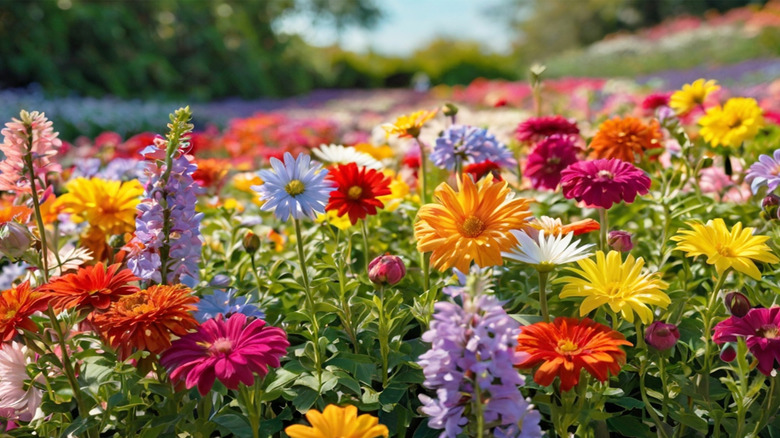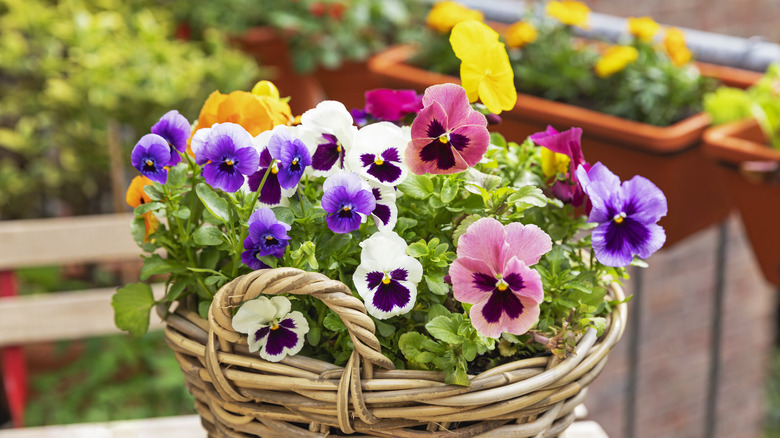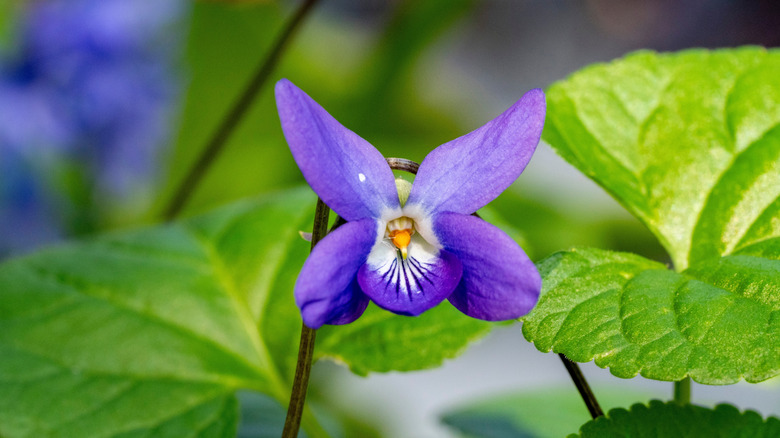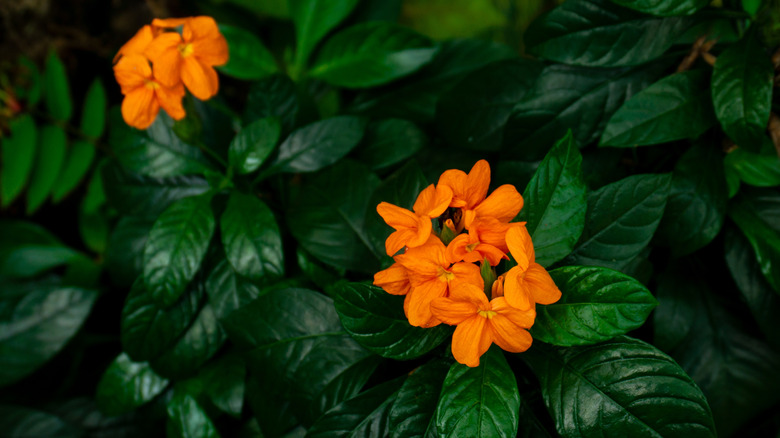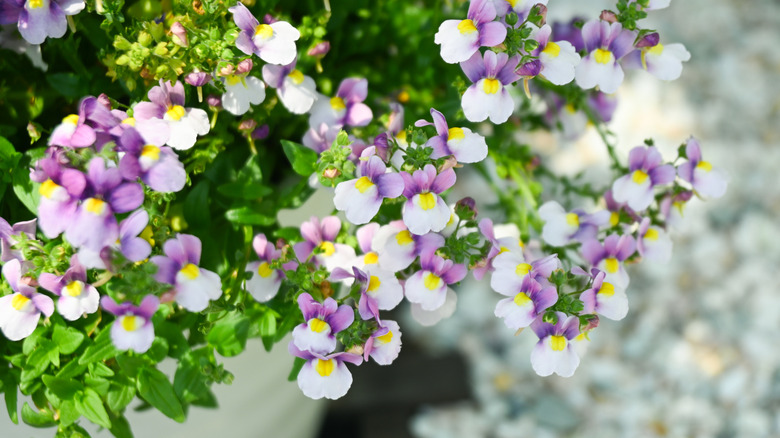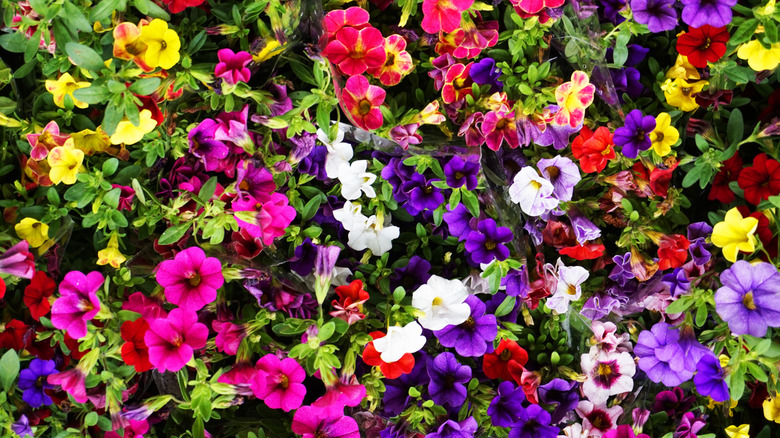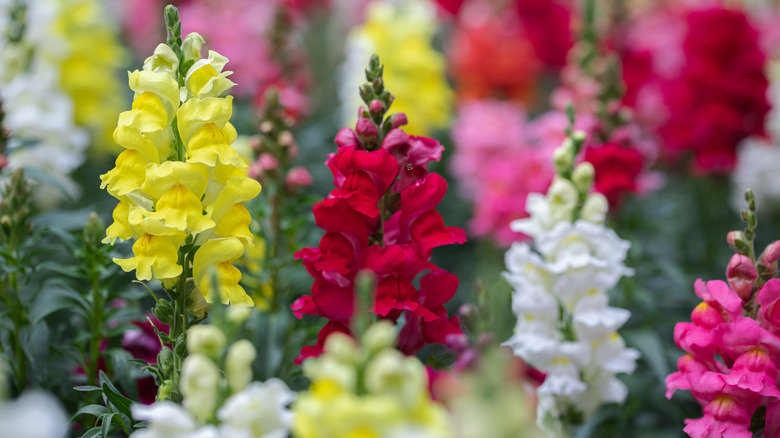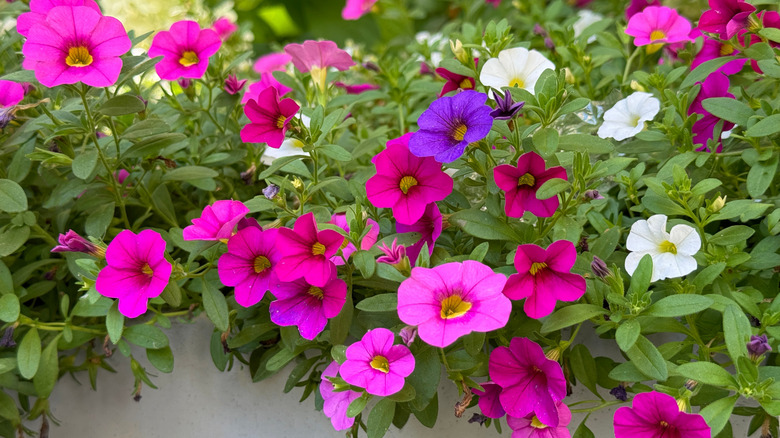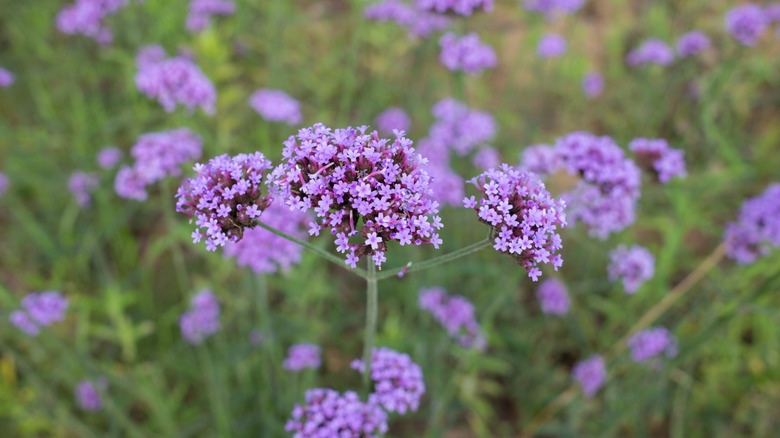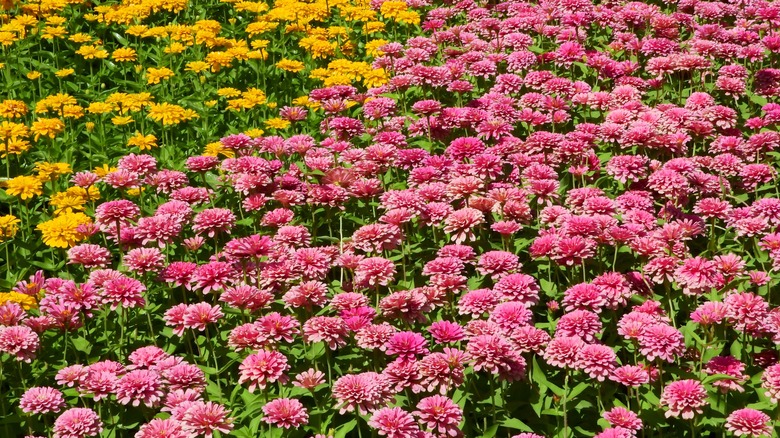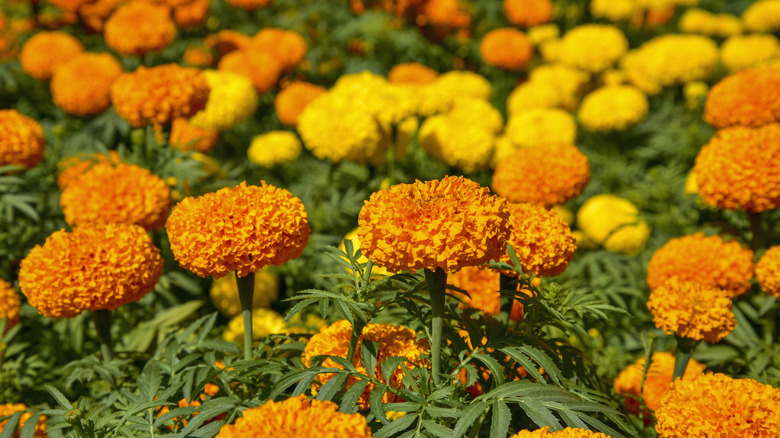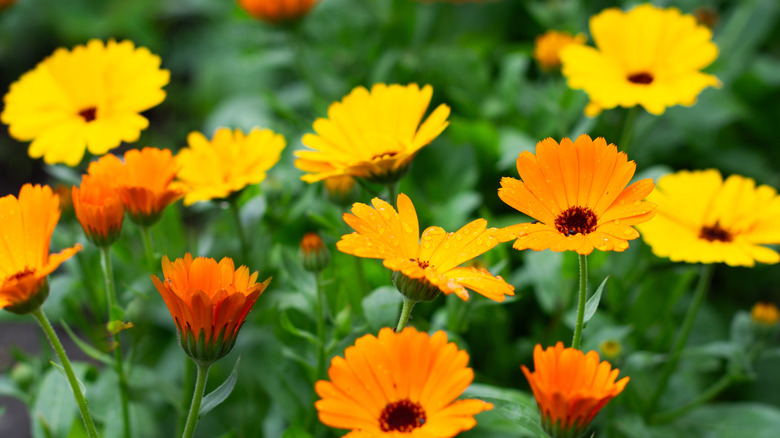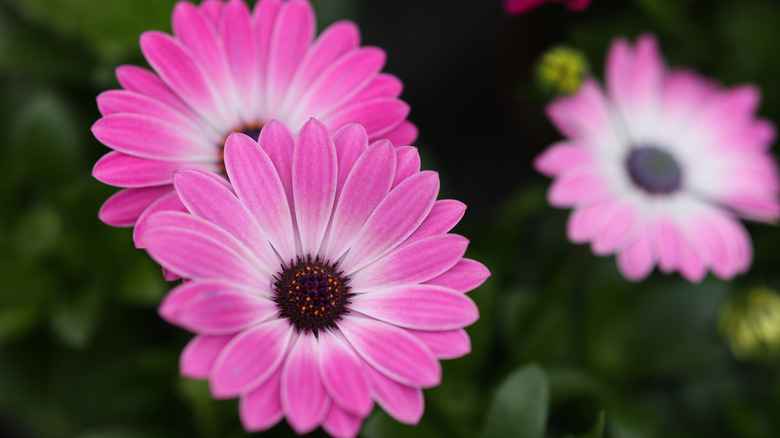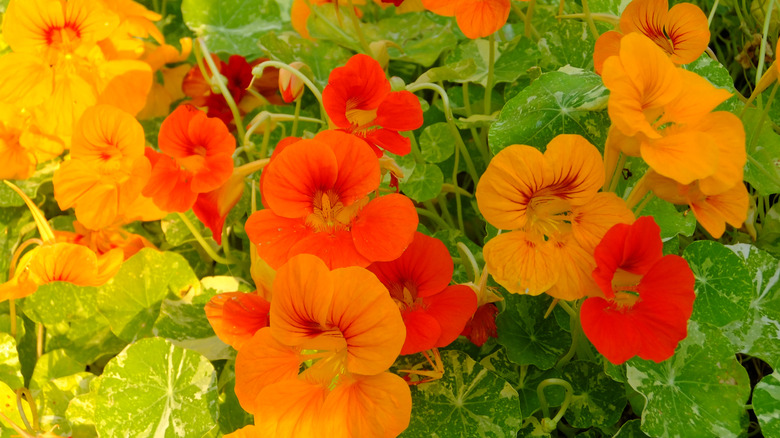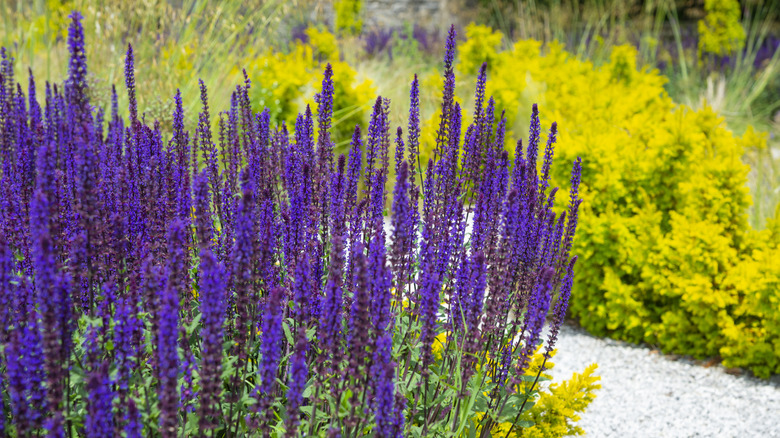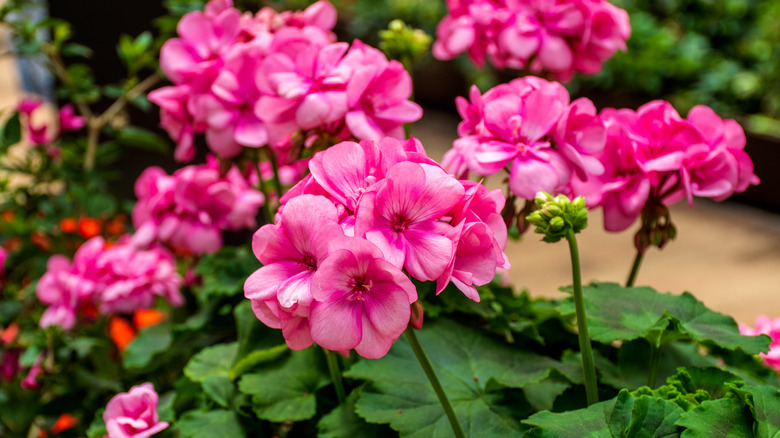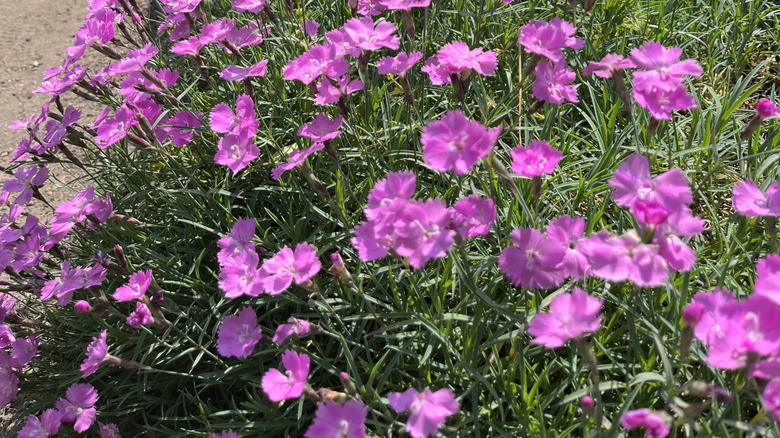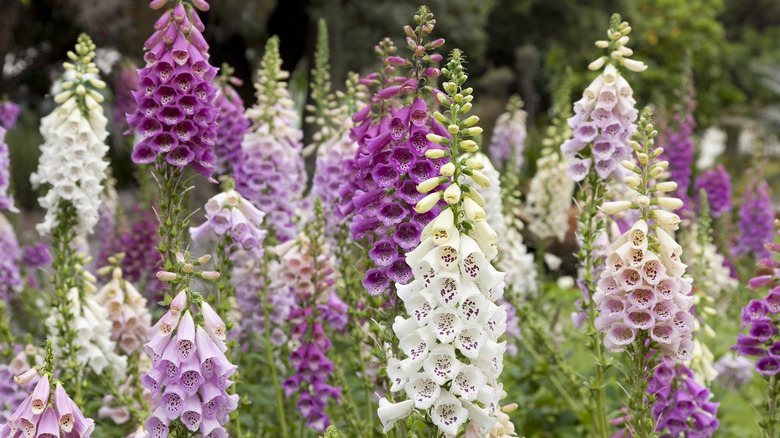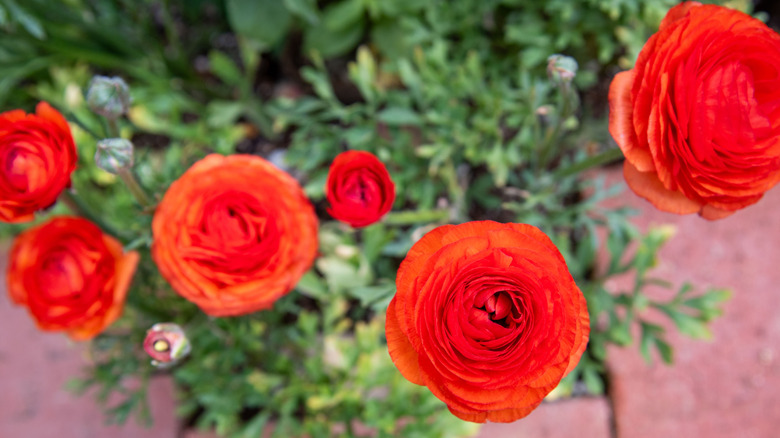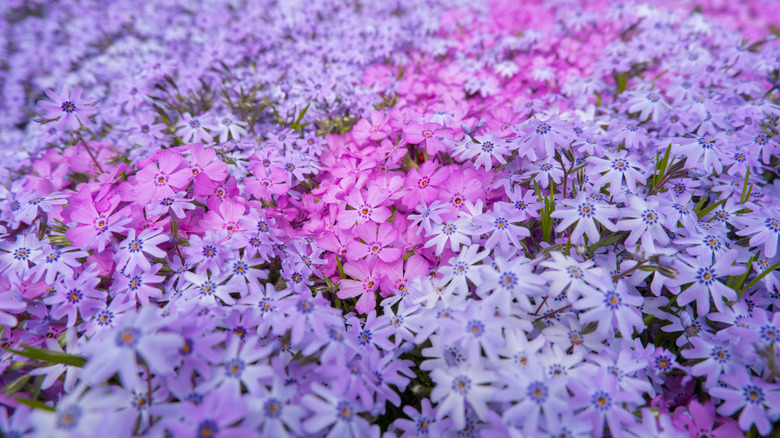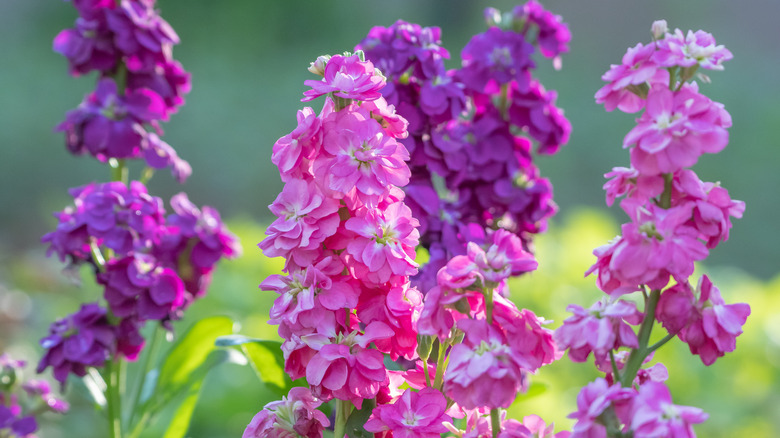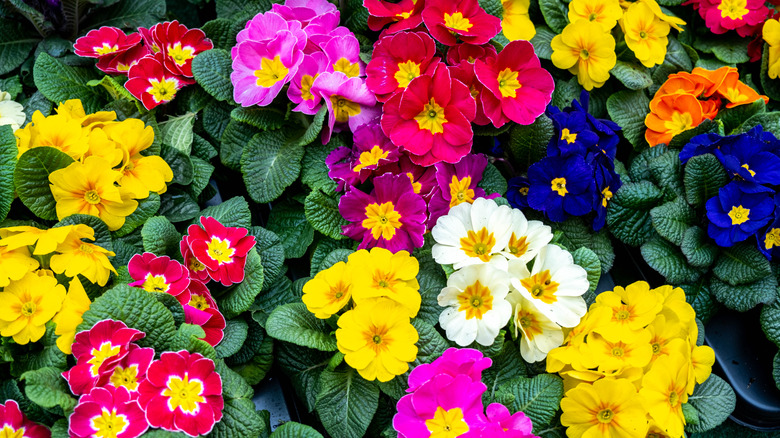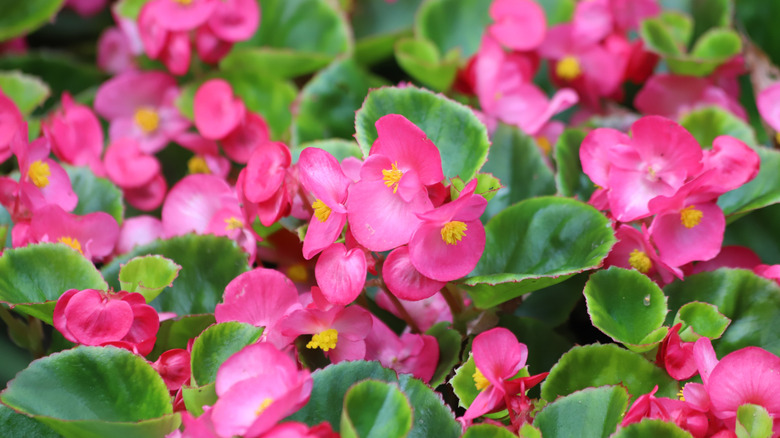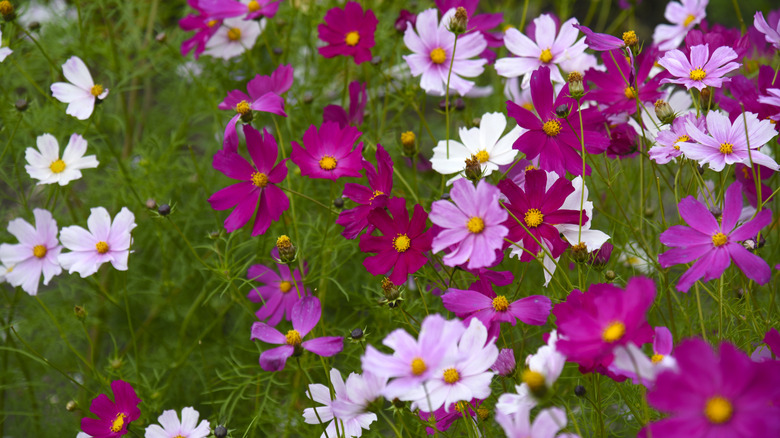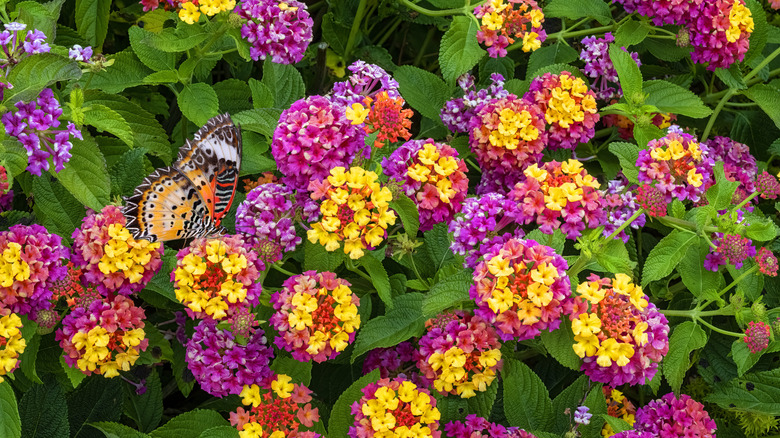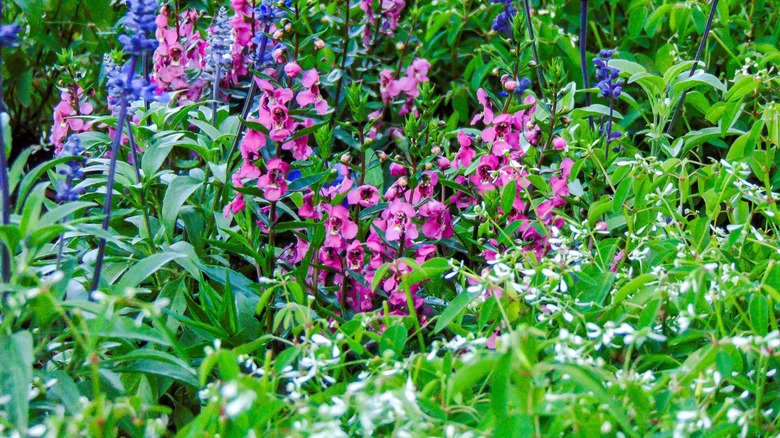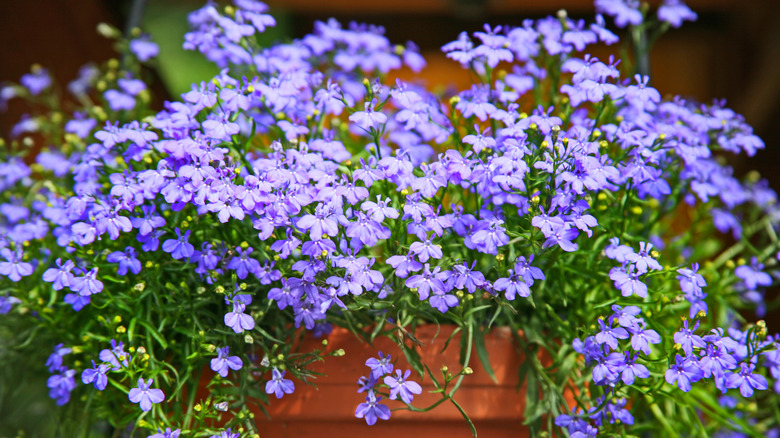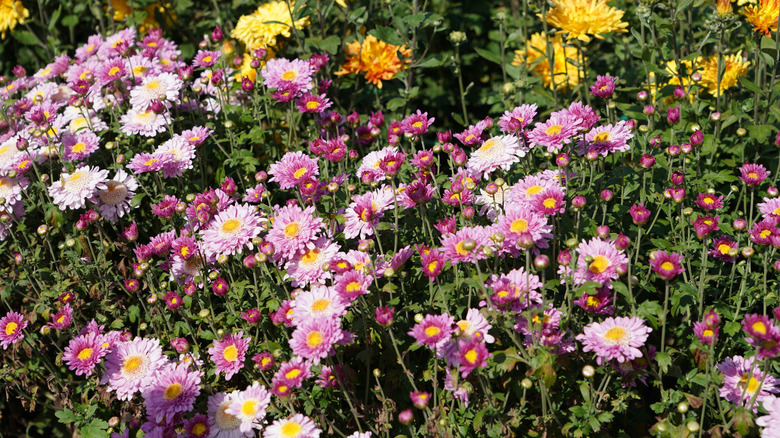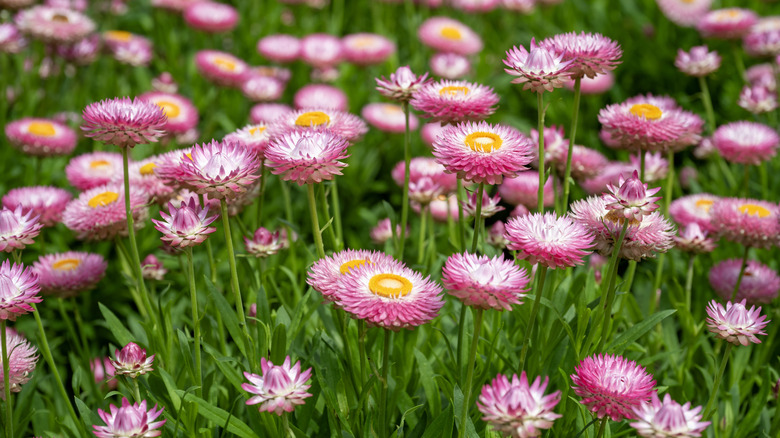28 Stunning Annual Flowers To Plant For A Colorful Garden Year-Round
Annual flowers can be a beautiful addition to any garden. Most gardeners already know there are plenty of flowering annuals that will last all summer, but what about the other seasons? While there are no annual flowers that bloom all year-round, you can use succession planting to make the most of your garden space. Or, you can plant different varieties in your garden to ensure stunning color throughout the year.
You will find some plants that have different varieties that bloom in all seasons, like pansies, violets, or crossandras, which you can plant in succession to achieve year-round color. In the spring, you can expect to see the beginnings of color popping up from annuals like African daisies, cheddar pinks, million bells, and snapdragons. Some of these plants have an extra-long bloom season, while others have varieties that can bloom in succession from spring to fall. In the summer, it's easy to fill your garden with long-lasting blooms from annuals, including wax begonias, cosmos, and chrysanthemums.
A lot of people think that fall is the end of colorful flowers and the beginning of colors from leaves changing, but it doesn't have to be. In the fall, you can keep your garden blooming with annuals like petunias, salvia, and strawflowers. Winter is a bit more difficult for some people, depending on their climate, but there are still flowers like primrose that can bloom in warmer regions.
Plant pansies for blooms in any season
Pansies (Viola x wittrockiana) are among the few annual flowers that have varieties that can bloom in any season. However, they may not bloom in every season in all regions. Most gardeners opt to grow pansies as annuals because they can't survive in high heat, especially in warmer summer climates. Pansies love cooler temperatures, so they do not bloom well throughout the summer unless you live in a cooler zone. In warmer climates, winter would be ideal for blooming. Most varieties prefer temperatures lower than 65 degrees Fahrenheit and can survive frost.
Violets can bloom year-round in some climates
There are some annual varieties of violets (Viola) that can bloom in any season, depending on your region. It is unlikely that you will be able to plant violets in succession to get year-round blooms since their season of interest is mostly dependent on both variety and location. For example, field violets can bloom in the spring, summer, and fall, but bog violets bloom only in the spring. However, you can try to select varieties that will bloom in alternating seasons with other flowers in your garden.
Crossandra produces continual blooms in tropical conditions
Crossandra (Crossandra infundibuliformis), also known as the firecracker flower, is a tropical annual flower that can bloom in any season in tropical regions. However, you can also cultivate it in temperate regions, but it will not survive all seasons. It grows to be about 2 feet wide and up to 3 feet tall. It needs temperatures of at least 55 degrees Fahrenheit, but preferably warmer, and humidity to survive.
Nemesia has a long blooming season for color from spring to fall
Nemesia (Nemesia strumosa) is generally grown as a cool-weather annual that grows in most regions in the United States. In mild climates, they can bloom from spring until the first frost. In warmer climates, they will only grow in spring or fall, but they will die back in summer. However, they can also be planted in containers and moved if the weather is too hot or too cold for a longer blooming season.
Million Bells provide a burst of color from season to season
Million bells (Calibrachoa x hybrida) are most commonly grown as annuals. If you're looking for long-lasting color, million bells may be just what you need. Each plant produces masses of blooms (hence the name) that cover the entire plant across a span of about 2 feet. Not to mention, several varieties of million bells that will attract pollinators to your yard from spring until the first frost, usually in the fall.
Snapdragons add tall, long-lasting color for borders or mass planting
Snapdragons (Antirrhinum majus) are another type of flower that is grown as an annual because they are delicate and don't often survive past the first year. They do, however, have an exceptionally long blooming season from spring to fall, making them a great flower to add to your garden for year-round color. They are also great for adding height to your garden without spreading widely.
Petunias bloom from frost to frost in garden beds or containers
Petunias (Petunia spp.) are long-blooming, showy annuals that offer a field of color in nearly every season. Most gardeners plant petunias from young plants purchased at a garden center. They can be placed in the ground from the last frost date in spring and produce blooms up to the first frost date in fall; however, they may get leggy. You can deadhead spent flowers or prune flowers on long, leafless stems to encourage new blooms.
Verbena offers versatility and early, long-lasting blooms
Verbena (Verbena spp.), also called vervain, is sometimes grown as an annual, depending on the variety. The plant offers versatile growing options because different varieties offer drastically different results, with some working well as a low ground cover, and others adding height up to 6 feet tall. They are known for their long blooming season and being one of the first flowers to bloom in the spring and the last flowers to die off in the fall. In warmer climates, they could even stick around through the winter.
Zinnias are the flowers that keep on giving with minimal effort
Zinnias are another flower that has an exceptionally long blooming season, from spring to fall. But the great thing about this annual is that it takes almost no effort to get these blooms to last. All you need to do is plant them in average soil, keep them moist until they are established, and then watch them grow. If you want more blooms, deadhead them when you see flowers wilting. That's it!
Marigolds are known for endless benefits, including lasting blooms
Marigolds (Tagetes spp.) are praised for being a companion plant, an insect repellent, and a pollinator attractor. But beyond those benefits, they are also an easy-to-care-for, long-lasting annual that adds color to any type of garden. Typically, they start producing blooms in late spring and will continue to flower until the first frost. You can deadhead spent blooms to encourage continued blooming. Plus, their bright yellow and orange colors make great additions to fall gardens.
Calendulas add interest to your garden for three seasons
Calendula (Calendula officinalis), also known as gold blooms or pot marigolds (though they are not true marigolds), are another low-maintenance annual that bloom from spring to fall. However, they do require a bit of extra work to get fall blooms. If left alone, they will bloom from spring to summer. If you want fall blooms, you will need to deadhead regularly.
African daisies add stunning spring to fall color
African daisies (Osteospermum spp.) are stunning annuals with beautiful blooms that come in red, blue, pink, purple, white, and yellow. In most regions, they begin blooming shortly after being planted in the spring until the first frost. The flowers may fade in the heat of summer, but after deadheading, they will return when temperatures cool down a bit.
Nasturtium provide bright pops of color
Nasturtium (Tropaeolum) is an annual flower with almost tropical-looking blooms that can grow in any region in the United States. The sizable, tubular flowers not only attract pollinators to your garden, but also give off a pleasant fragrance that freshens up your garden space. When properly cared for and regularly deadheaded, you can expect to see colorful blooms filling your garden from late spring to fall.
Salvia adds long-lasting color, aroma, and butterflies to your garden
Salvia (Salvia spp.) is also commonly called sage, and sometimes people use the terms interchangeably, but there is a difference. So, should you call it sage or salvia? If you are looking to add a colorful flower to your garden that will last through spring, summer, and fall, you are looking for Salvia. You can leave the sage in the kitchen. Salvia plants produce ornamental purple flowers that fill your garden with color, an earthy fragrance, and pollinators for season after season.
Annual geraniums may not bloom until summer, but they provide color until frost
Annual geraniums (Pelargonium spp.) aren't technically geraniums; they are in the Pelargonium genus, but they are commonly referred to as geraniums by most gardeners. If you plant them in the spring (after nighttime temperatures are higher than 55 degrees Fahrenheit), you could see blooms as early as late spring, but most likely early summer. With proper deadheading, you can keep them blooming all the way until the first frost.
Cheddar Pinks cover the ground in a bright blanket early in the season
With over 27,000 cultivar names of cheddar pinks (Dianthus), these beautiful flowers can be grown with almost any lifecycle, including annual. They are slow-growing, but they are often used as ground cover that attracts bees and butterflies. They have a shorter growing season but provide vibrant color through both the spring and the summer, making them a great option for your early-season color.
Foxglove adds a dense pop of color for two seasons
Foxglove (Digitalis purpurea) is a self-seeding plant that is commonly treated as an annual. They tend to grow well in mass planting applications. However, foxglove is considered invasive in some regions, such as California, so be sure to check local regulations before planting. While they only bloom in the spring and summer, they produce showy, dense blooms that can add the pop of color you are looking for.
Persian buttercup provides stunning blooms from spring to summer
Persian buttercup (Ranunculus) is another short-lived flower that won't fill your garden all year, but it can be the perfect addition for your spring garden if you are alternating with fall varieties. It will bloom in spring and summer with stunning, rose-like flowers that die off just in time for your summer and fall blooms to open.
Drummond's phlox brings a delicate touch to welcome the spring
Drummond's phlox (P. drummondii) is an annual variety of phlox flower that grows lower than perennial phlox varieties at about 2 feet. These smaller, delicate flowers are still known for attracting butterflies and deterring deer, but they don't do well in heat. Generally, they will bloom in the spring and into the early summer, but will die off in the heat of summer. Luckily, this is just in time for fall flowers to bloom.
Stock can be planted in succession for endless blooms in the right climate
Stock (Matthiola incana) is technically a herbaceous perennial, but it is often grown as an annual. It generally blooms from late spring to summer. However, you can plant it in succession every two weeks to make your blooming season last longer. It will die if temperatures exceed 80 degrees Fahrenheit, but they will bloom as long as they get at least two weeks of temperatures between 40 and 55 degrees Fahrenheit. So, depending on your region, you could have stock flowers in different seasons with smart planning.
Primrose brings color through the winter
Primrose (Primulas spp.) is one of the few plants that will help you truly achieve year-round color in your garden because it blooms in the winter and spring. It can be planted as a perennial in warmer climates, but it won't survive multiple rounds frost. It can also produce blooms in the winter in areas that don't have the risk of frost. Blooms will start to appear in late winter in cooler climates. It's also a versatile plant that can thrive in containers or mass plantings.
Wax Begonia produces continual blooms after spring flowers fade
Wax Begonias (Semperflorens Cultorum group) are generally grown as an annual in temperate zones. They are a great addition to your garden for year-round color because they will last through summer and fall after your spring flowers have died off. Generally, they will begin blooming sometime in May or June and will keep blooming until the first frost.
Cosmos are an easy way to add color in the later seasons
Cosmos (Cosmos bipinnatus) is a low-maintenance annual that grows well with other flower varieties to enhance your summer or fall garden. Once planted, they will take about 7 weeks to begin blooming. Once they are established, however, they will bloom until the first frost. Check with your local extension office before planting cosmos in your garden because they are considered invasive in some regions, like West Virginia.
Lantana has versatile growing options for any planting style
Lantana (Lantana camara) can be grown as an annual in any region, though mainly in temperate regions. It does well in containers, so it is commonly grown in planters or hanging pots. Known for its long blooming season, lantana produces blooms from summer to fall. This species is considered invasive in some areas, like Florida, so it is important to check locally before planting.
Summer Snapdragons are great for filling a summer garden with color
Summer Snapdragons (Angelonia angustifolia), also simply known as Angelonia, are generally treated as annuals in cooler climates. Angelonia flowers are perfect for sunny yards with pets, and they will provide stunning color in your summer garden. They begin to bloom just in time for spring varieties to die off and will continue flowering until fall.
Annual lobelia provides wide blooms for months on end
Annual lobelia (Lobelia erinus) is a smaller variety of lobelia that is grown as an annual in most areas. It is known for its long blooming season and low, spreading habit that creates full containers or ground cover in gardens. It can bloom from spring until fall, but flower production may slow through part of the summer as it prefers colder weather for blooming.
Chrysanthemums fill your garden with colorful blooms in the fall
Chrysanthemums (Chrysanthemum x morifolium) are yet another long-blooming flower that is grown as an annual in most gardens, especially when used for fall decoration. When planted in the spring, they will begin producing blooms in the summer and into the late fall. Unlike other flowers that bloom depending on temperature, chrysanthemums bloom based on the length of the day. Once the days have less than 12 hours of sunlight, blooms will flourish.
Strawflowers add long-lasting color to your garden or your table
Strawflowers (Xerochrysum bracteatum) are grown as annuals in temperate regions. They are known for not only having a long bloom season in the late spring to late fall, but also being long-lasting as cut flowers. With varieties in yellow, orange, pink, red, and white, they attract pollinators all season. For more regular blooming, try consistently deadheading to encourage more blooms.
